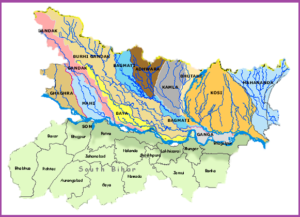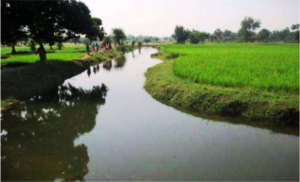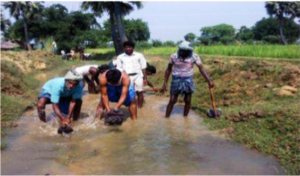
Agriculture in Bihar has remained stagnant in spite of the rich soil, abundance of easily accessible water and a rich peasant tradition. The stagnation has been ascribed to several factors including the ecological conditions, demographic pressure and most importantly, the land tenure system and the agrarian structure it supports. These factors are believed to have impeded the transition of Bihar’s agriculture from a semi-feudal to capitalist production system, an essential condition for agricultural growth.
Due to rapid groundwater development, agriculture in eastern India made a rapid turnaround in 1980’s, yet the growth in agricultural production and productivity in Bihar was at a much slower pace. To offset the inequity in landholdings, several have advocated (a) machine reforms, which would be adopted by small cultivators, and (b) an emphasis on the role of local markets in technological inputs to overcome the constraints posed by technology.
The dependence of poor and middle peasants on big farmers for loans at very high rates to cover the consumption and input costs (which have risen sharply through the 1990s) has increased. And, wherever small and marginal farmers (who were formerly into subsistence agriculture) have adopted high yielding varieties, it has more often than not, been in order to pay rents and service debts.
The first phase of agricultural development marked by widespread introduction of tubewell and pumpset irrigation in Bihar saw a process of accumulation among larger cultivators. In the second phase, these inputs were adopted by the small and marginal cultivators mostly through hiring of diesel pumps, electricity being a problem since 1980’s in Bihar. Machine owners can as a consequence extract high monopoly rents. The cost of groundwater which is relatively more abundant in the region is very high, given the dismal power situation.
It is in this backdrop, that the ahar pyne systems hold a lot of potential for providing irrigation in South Bihar.

AHAR PYNE IRRIGATION SYSTEMS OF SOUTH BIHAR
Ahar-pyne system is an indigenous irrigation technology, which continues to irrigate substantial areas even today in South Bihar plains of India. This system has evolved from an understanding of the particular agro-climatic conditions of the region.
Ahars are reservoirs and consist of a major embankment across the line of the drainage with two side embankments running backwards up to the line of the drainage gradually losing their heights because of the gradient of the surface. Thus, an ahar resembles a rectangular catchment basin with only three embankments, and the fourth side left open for the drainage water to enter the catchment basin following the natural gradient of the country.
These are very different from the regular tanks in that neither their beds are dug out nor do the regular tanks have elevated embankments as do ahars. Water supply for an ahar comes either from natural drainage after rainfall (rainfed ahars) or through pynes where necessary diversion works are carried out. Water for irrigation is drawn out by opening outlets made at different heights in the embankment. Ahars, with sides that are more than a km. long, irrigating more than 400 ha are not rare, though smaller ones are more common . However, the average area irrigated per ahar during the early twentieth century was said to be 57.12 ha.
Pyne is the local name for the diversion channels. These channels may be of various sizes. The small ones are those found originating in ahars and carrying the water of the ahars to cultivable plots. The large ones have their origins in rivers from which water is diverted through these artificial channels by erecting embankment in the river beds. They are led some way upstream above the level of the land they are intended to irrigate. It is often 3 to 5 kms before the water of the pynes reaches the level of cultivation. Some of the biggest pynes are 16 to 32 kms. In length, and some of the them known as dasian pynes (pynes with 10 branches) irrigate many thousand acres of lands of hundreds of villages.
Ahar beds were also used to grow a rabi (winter) crop after draining out the excess water that remained after kharif (summer) cultivation.

DISTRIBUTION OF WATER
In South Bihar the most common system of water distribution is that the water first goes to the upper reach field which is closest to the irrigation channel and then goes to the next field. This field to field irrigation is resorted to because ahar-pyne irrigation is used mainly for the paddy crop, where even a little extra water does not cause any harm to the crop. As pynes served many villages, each village had its fixed turn of days and hours to have the water. These turns known as parabandi were most equitable and just modes of water allocation. The equity aspect of water distribution among individual cultivators which continues even today is obtained because all farmers, rich or poor and big or small, have plots in head and tail positions of the irrigation channel. As a result, adequacy or shortage of irrigation water is equitably shared by all cultivators of the irrigation command. The reliability and timeliness of ahar irrigation is ensured because water is stored in the reservoir and is utilized when pynes do not have any water left and rains are not forthcoming. This is the likely scenario during the hathia period, when water is critically needed by paddy.

REPAIR AND MAINTAINANCE OF AHAR- PYNE
The routine upkeep work involves cleaning and desilting of ahar and pyne and maintaining the water conveyance network, while the system is in operation. As a result, ordinary maintenance such as the periodic clearance of silt, the repair of small branches of the ahars and field channels is done by the cultivators themselves under goam system and it starts before the onset of monsoon. Thus, people’s collective action finds place in operational as well as in maintenance works.
The maintenance work includes desilting of ahar and pyne beds, regular repair of embankments. Apart from these routine activities, an important task is to keep constant vigil, particularly during monsoon against sudden damage of protective works which may occur due to natural cause or due to man-made reasons. The operational works include cutting and closing embankments for diversion, erection of bandhs or garandis across the pynes, opening and closing of outlets and at times even resorting to manual water lifts to irrigate uplands.
Further, the quality of construction is quite good because those who get engaged in the repairs are themselves the beneficiaries. Further, in some of the repairs the material used is the one which is locally and easily available. The use of mozar which is obtained by mixing the wet mud with paddy straw quite effective in the repairs of embankment, including in raising its height.

SUSTAINABILITY
The sustainability of ahar-pyne system can be judged by the fact that these modes of irrigation are in existence for centuries. Writing in the early part of this century. All the ahar-pyne systems that exist today are at least nearly hundred years old. The main reason of the sustainability of these indigenous systems is that the advantages emanating from them are two fold. First, these systems utilize water which otherwise would be wasted. Second, these systems, particularly in the past, saved the plains of South Bihar from the recurrent floods which otherwise would have devastated the countryside regularly.

Source
https://www.iucn.org/regions/asia/countries/india/sustainable-agriscapes-future-project
https://www.slideshare.net/livolinkfoundation/igs-15708670
http://nopr.niscair.res.in/handle/123456789/13855
https://bjmirror0810.wordpress.com/


